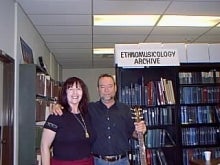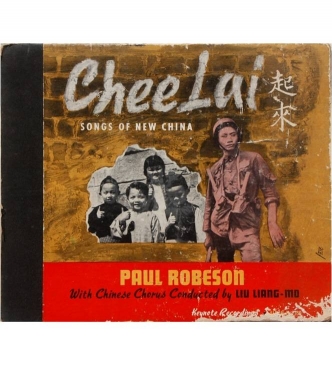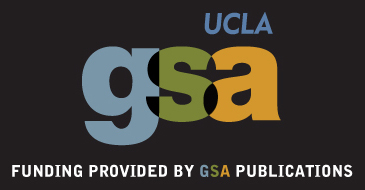UCLA Ethnomusicology Archive - Introductions

Maureen with legendary Australian singer, John Williamson
Opening lines are hard. You need to grab the reader. You need to set the scene. You want to be witty. You need to be pithy. You need to start writing.
Allow me a brief introduction. I have been an Archivist-Librarian at the UCLA Ethnomusicology Archive longer than I should probably publicly acknowledge. (The incoming freshmen were born in what year?) Professors Jacqueline DjeDje and A.J. Racy were on the Search Committee that hired me. Professor Nazir Jairazbhoy was Chair of the newly-minted Department of Ethnomusicology and his office was next door to the Archive.
It is my hope that many of this series' readers are already familiar with the UCLA Ethnomusicology Archive.
Founded in academic year 1960/61 as a research unit of the then Institute of Ethnomusicology and opened on October 13, 1961, the Ethnomusicology Archive is a vital part of UCLA Ethnomusicology’s mission to explore the rich variety of musical expressions throughout the world by combining hands-on musical experience with academic study.
Holding over 150,000 audiovisual recordings, the Archive collections include non-commercial field recordings and commercially produced recordings of traditional, folk, popular, and art music from Africa, Asia, Australia and the Pacific islands, Europe, the Middle East, and the Americas on a variety of formats. The UCLA Ethnomusicology Archive is one of the largest ethnographic sound archives in North America. (Only the American Folklife Center’s Archive is bigger.)
I want to thank the EMR Editorial Board for inviting me to write a series about archives and archiving. Along with sharing information about archives in general and the UCLA Ethnomusicology Archive in particular, we hope to open a public forum for discussions of the roles that archives can play in 21st-century ethnomusicology. Please email me and let me know if there is anything particular that you would like me to discuss or anything you, as readers and participants, want to discuss.
Series such as this tend to be organic, so things could certainly change as the column grows and develops, but there are some things that we thought would be of interest to readers.
“World Music” and Archives around the Internet -- a weekly recap of relevant links (those of you who follow the Ethnomusicology Archive on Facebook know that I am pretty link-happy.)
Highlights from the Ethnomusicology Archive -– talking about collections we have or have just received or items in the collections that are just plain cool.
Archives and Archiving -- a short essay or position paper relevant to music archiving.
Special Guests -- we hope to invite participation from colleagues at other institutions who would like to share their thoughts or stories.
This week, I thought I would remind everyone that the Ethnomusicology Archive’s “commercial” recordings are sometimes almost as rare as our field recordings. We often hold the only copy in North America, if not the world.
As Professor Helen Rees dubbed the find below, “What a nice surprise” or “Things I wouldn’t have thought of…”

[To listen to a 40-second sample of Paul Robeson singing "Chee Lai," please click on the link at the bottom of the page.]
I also want to remind everyone that there are astonishingly rich archival resources throughout the Southern California area. For anyone interested in California Indian music or Spanish-language songs from early California, read my current “Off the Beaten Path” column in Music Reference Services Quarterly.1 I interviewed Kim Walters, Interim Director of the Southwest Museum of the American Indian, about the Braun Research Library at the Southwest Museum. The Braun holdings include a unique collection of nearly 1000 wax cylinder recordings. Of those, more than 700 are of Mexican American and Native American songs recorded by Charles F. Lummis between 1895 and 1912 in the Southern California area. They are believed to be the first recordings of Mexican American folk songs in California. To listen to sound samples, check out the Autry's collection spotlight, Spanish Songs of Old California.
Since I opened this column talking about opening lines, it seems only fitting that I close with two of my favorites…
“Far out in the uncharted backwaters of the unfashionable end of the Western Spiral arm of the Galaxy lies a small unregarded yellow sun.” -- The Hitchhiker’s Guide to the Galaxy, Douglas Adams
“He was born with a gift of laughter and a sense that the world was mad.” -- Scaramouche, Raphael Sabatini
- 1. Music Reference Services Quarterly, published by Taylor & Francis, is a refereed journal covering all aspects of the management and use of music collections and services in academic, orchestra, public, conservatory, and performing/fine arts libraries, as well as archives and museums.





